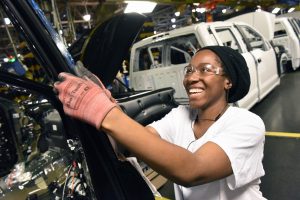The Rebirth of American Manufacturing, One Clean Car or Truck at a Time
New far more efficient cars, SUVs, and trucks are on track to save Americans tens of billions of dollars at the pump while making the historic cuts in carbon pollution—all while creating and sustaining quality jobs for American workers.

Photo Credit: Ford Motor Co.
For many residents of America’s industrial towns and cities across the country, the auto industry is the lifeblood of their economy. In these communities, generations of workers have built a good life for themselves and their families working at the plants that build the automotive parts, materials, electronics, and the vehicles we drive every day. Increasingly, these communities are thriving again because of the resurgence of America’s auto industry. But, only a few years ago, the very survival of these plants and the communities they support was in doubt.
Even before the full realities of the Great Recession were known, the towns and cities that relied on the auto industry were seeing tough times. Manufacturing in our country was taking a beating, local manufacturers were shuttering plants, off-shoring , or downsizing at an alarming rate. Good jobs became scarce and families struggled. All manufacturers were impacted, and the U.S. auto industry was on the brink of collapse. Some said the end of good manufacturing jobs was inevitable.
They were wrong.
Today, the U.S. manufacturing sector is slowly, but steadily, returning and many manufacturing communities are recovering. This renaissance is due, in part, to a national commitment that was made to building the next generation of advanced clean vehicles in America with the sound policies to make it happen.
The auto industry is at the heart of American manufacturing and over the past decade, cars, trucks and the industry itself have been transformed. Since the recession, the auto industry has brought back 700,000 jobs in manufacturing plants and at dealerships. These jobs, in turn, support several million more jobs throughout the economy. Companies are profitable, and sales are at near record levels.
The industry isn’t just bringing back jobs. New far more efficient cars, SUVs, and trucks are on track to save Americans tens of billions of dollars at the pump while making the historic cuts in carbon pollution.
Thanks to landmark fuel economy standards and greenhouse gas standards for cars and trucks—working in concert with sound manufacturing policies that help ensure we don’t just invent new technology, but manufacture it here—clean vehicle innovation is happening across every type of car and truck, and in the parts and materials that go into them.
For example, the 2015 Ford F-150 pickup truck gets 21 percent better fuel than the same truck in 2010 (and is even more powerful!). Achieving those gains meant investment and innovation in plants nationwide. Ford invested billions to retool its plants in Missouri and Michigan and hired hundreds of additional workers to build the new truck with new fuel-efficient components and materials. The Kansas City Assembly plant today employs 6,450 people making the popular new trucks, the most since the plant was opened in 1951.
The path to achieving these pollution reductions includes an innovative new engine from Ford’s Engine Plant in Cleveland; investments to expand an aluminum plant and add jobs in Tennessee and Iowa; more rapid innovation, new investment, and jobs making high-strength lightweight steel in Ohio; and fuel-saving electric power steering from a company in Michigan, which today is the largest employer in Saginaw County.
A similar story could be told about General Motors’ popular pickup, the Chevy Silverado, which rolls out for the first time this year not only with innovative engine and transmission technology (also made in plants across the country), but a fuel-saving light hybrid assist, drawing on electric drive technologies developed and built in Michigan, Maryland, and other states, and that’s also used in the Chevy Malibu, which meets 2021 fuel economy standards today.
America’s auto resurgence is a true success story that shows what it looks like to combat climate change and rebuild the economy—and our manufacturing communities—at the same time. Workers in the industry truly show that we don’t have to choose between good jobs and a clean environment; we can and must have both to build a prosperous future.